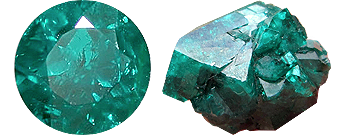 Photo of Dioptase in Processed & Rough Form
Photo of Dioptase in Processed & Rough Form
Dioptase is a mineral with a hardness of 5 out of 10 on the Mohs scale of mineral hardness [?]. These Trigonally structured gems are made of hydrated copper silicate, their full chemical compound being CuOSiO2H2O.
Dioptase is a relatively rare emerald-green mineral, sometimes tinged bluish or blackish. Crystals are small with a vitreous luster, and is transparent to translucent. Its green is very strong and bright even when compared to the more subtle green of emerald.
It forms green to blue-green encrustations and fillings of enamel-like or earthy texture. It is uncommon, and found in the weathered zones of copper sulfide deposits, where copper veins have been altered by oxidation, and in hollows and cavities in the surrounding rocks. It is usually associated with limonite, chrysocolla, cerussite, and wulfenite.
The mineral forms prismatic crystals, often with rhombohedral terminations. It may occur as crystalline aggregates, or in a massive habit.
It is soluble in hydrochloric acid, nitric acid, and ammonia, leaving a silica residue, and is infusible.
Dioptase crystals mined at Mt. Altyn-Tyube (USSR) were first thought to be emeralds. But their low hardness easily distinguishes them from emeralds, which is one reason why dioptase is not more valued.
Occurrences of dioptase are found in Kazakhstan, Reneville (Zaire), minor deposits at Baita (Romania), Copiapo (Chile), Mammoth Mine, Tiger, Arizona (USA), and Otavi Range at Guchabo (Namibia).
Achirite is an obsolete name for dioptase.
Misleading terms for dioptase include "Congo emerald" or "copper emerald" for dioptase from Congo (Africa), as well as "emeraldine," "emerandine," "emerald malachite," "esmeralda cobre," "Scythian emerald."
Why isn't Dioptase used more in jewelry?
Despite its stunning emerald-green color, dioptase's low hardness (5) and perfect cleavage make it extremely fragile for jewelry use. Most specimens are preserved for mineral collections rather than cut into gems.
What makes Kazakhstani Dioptase special?
The original Altyn-Tyube deposits in Kazakhstan produce exceptional crystals with intense color and high luster. These historic specimens set the standard for quality and remain among the finest known examples.
Why is the color so intense?
Dioptase's remarkable green color comes from its high copper content. The crystal structure creates one of the most intense natural green colors in the mineral kingdom, often appearing almost electric in quality specimens.
Are large Dioptase crystals real?
While most dioptase forms as small crystals, larger specimens do exist, particularly from Congo and Namibia. Crystals over 2cm are considered large and highly valuable, especially if they show good transparency.
How can I tell genuine Dioptase from similar minerals?
Look for distinctive hexagonal crystal form, perfect cleavage, and vitreous luster. The color should be consistently deep green, and crystals often form in drusy crusts. It's softer than similar-looking emerald or chrome tourmaline.
Why do some specimens appear black?
Very dark green dioptase can appear almost black, especially in larger crystals. When examined with strong backlighting or at crystal edges, the true green color becomes visible. Thinner crystals show brighter green.
Are Namibian Dioptase deposits still producing?
Tsumeb mine in Namibia produced exceptional specimens but is now closed. Modern specimens mainly come from Congo and Arizona, though they rarely match the quality of classic Tsumeb or Kazakhstan material.
Dioptase's Healing and Metaphysical Properties: Dioptase has been used historically for it's psychotherapeutic properties. In general the Crystal is used to heal love sickness and allow persons to forgive.
The specific gravity [?] for Dioptase is 3.31, its refractive index [?] is 1.67-1.72, and its double refraction [?] is 0.053.
History
Fine cleavages in dioptase crystals sometimes give a pearly luster and interesting internal reflections, and this accounts for its name which comes from the Greek words for "through" and "visible."
Dioptase has only had general recognition in Europe since it was introduced in 1780 to St. Petersburg, where it was wrongly identified as a variety of emerald called "achrite." A related copper silicate mineral is Chrysocolla.
Industrial Usages
It has no industrial importance, but is popular with collectors. It has been called "copper emerald" or "the emerald of the poor." The crystals found in Zaire, at Reneville, are quite large and may be cut for jewelry. Due to its low hardness and perfect cleavage, faceted stones are comparatively rare.





